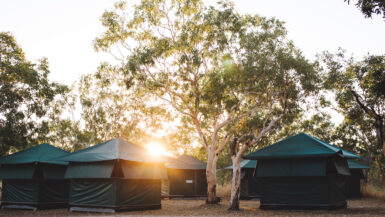Camping is a great way to connect with nature and escape the hustle and bustle of city life. However, with the increasing concerns over the impact of tourism on the environment, it is important to choose eco-friendly camping sites that prioritize sustainability and conservation. The Middle East is home to some of the most stunning natural landscapes, from the deserts of Jordan to the mountains of Oman, and there are many eco-friendly camping sites that offer an immersive and responsible camping experience. In this article, we will explore some of the best eco-friendly camping sites in the Middle East that not only provide a unique outdoor experience but also promote sustainable tourism practices.
Introduction to Eco-Friendly Camping and Its Benefits
Camping is a popular activity that allows people to connect with nature and escape the hustle and bustle of city life. However, traditional camping practices can have negative impacts on the environment. That’s why eco-friendly camping has become increasingly popular in recent years. Eco-friendly camping, also known as sustainable camping, involves using environmentally friendly practices to reduce the impact on the environment while camping.
The benefits of eco-friendly camping are numerous. Firstly, it helps to preserve the natural environment and wildlife by reducing pollution and waste. Secondly, it helps to minimize the use of non-renewable resources such as water and energy. Thirdly, it promotes a deeper connection with nature and encourages people to adopt more sustainable lifestyles. Finally, eco-friendly camping is often more cost-effective in the long run, as it reduces the need for expensive gear and equipment.
In this article, we will explore the best eco-friendly camping sites in the Middle East. These campsites have been carefully selected based on their commitment to sustainable practices and their unique natural beauty. We hope that this guide will inspire you to experience the beauty of the Middle East while also protecting the environment for future generations.
Overview of the Middle East’s Natural Beauty and Camping Opportunities
The Middle East is a region renowned for its rich history, diverse culture, and stunning natural landscapes. From the deserts of Saudi Arabia to the mountains of Lebanon, there are countless opportunities for eco-friendly camping in the Middle East.
One of the most iconic natural features of the Middle East is the Arabian Desert, which spans across several countries, including Saudi Arabia, Oman, and the United Arab Emirates. Camping in the desert can be a unique and unforgettable experience, with opportunities for stargazing, camel riding, and exploring ancient ruins.
For those who prefer a more mountainous terrain, the Taurus Mountains in Turkey and the Zagros Mountains in Iran offer incredible views and challenging hiking trails. The Al Hajar Mountains in Oman are also a popular destination for camping and trekking, with several eco-friendly campsites available.
The Middle East is also home to several stunning coastlines, including the Red Sea in Egypt and the Persian Gulf in Oman. Camping near the beach can provide a relaxing and rejuvenating experience, with opportunities for swimming, snorkeling, and diving.
Overall, the Middle East offers a diverse range of natural beauty and camping opportunities, making it an ideal destination for eco-friendly travelers. In the next section, we will discuss the criteria for selecting eco-friendly camping sites in the Middle East.
Criteria for Selecting Eco-Friendly Camping Sites
When selecting eco-friendly camping sites in the Middle East, there are several criteria to consider. These criteria will ensure that the campsites you choose are committed to sustainable practices and will help to minimize your impact on the environment.
The first criterion to consider is waste management. Look for campsites that have proper waste disposal systems in place, including recycling facilities and composting toilets. This will help to reduce the amount of waste that ends up in landfills and minimize the impact on the surrounding environment.
The second criterion is energy and water conservation. Choose campsites that use renewable energy sources, such as solar or wind power, and have water conservation practices in place, such as low-flow showerheads and toilets. This will help to minimize the use of non-renewable resources and reduce your carbon footprint.
The third criterion is location. Choose campsites that are located in areas with minimal impact on the natural environment. Avoid campsites that are located in protected areas or areas with sensitive ecosystems.
Finally, look for campsites that are committed to responsible tourism practices, such as supporting local communities and minimizing the impact on cultural heritage sites.
By considering these criteria when selecting eco-friendly camping sites in the Middle East, you can ensure that you are making a positive impact on the environment and supporting responsible tourism practices. In the next section, we will explore the top eco-friendly camping sites in the Middle East that meet these criteria.
Top Eco-Friendly Camping Sites in the Middle East
The Middle East is home to several eco-friendly camping sites that offer beautiful natural landscapes and sustainable practices. Here are some of the top eco-friendly camping sites in the Middle East:
1. Wadi Rum, Jordan
Wadi Rum is a desert valley in southern Jordan that offers stunning red sandstone formations and unique rock formations. There are several eco-friendly campsites in Wadi Rum that offer traditional Bedouin tents and sustainable practices such as solar-powered lighting, composting toilets, and recycling facilities. Activities include camel riding, hiking, and stargazing.
2. Al Gharbia, Abu Dhabi
Al Gharbia is a remote region in the western part of Abu Dhabi that offers stunning desert landscapes and unique wildlife, including Arabian oryx and gazelles. There are several eco-friendly campsites in Al Gharbia that offer traditional Bedouin tents and sustainable practices such as solar-powered lighting and composting toilets. Activities include camel riding, falconry, and dune bashing.
3. Al Hajar Mountains, Oman
The Al Hajar Mountains in Oman offer stunning views and challenging hiking trails. There are several eco-friendly campsites in the Al Hajar Mountains that offer traditional Bedouin tents and sustainable practices such as solar-powered lighting and composting toilets. Activities include hiking, rock climbing, and visiting local villages.
4. Eco-Dome, Jordan
Eco-Dome is a unique eco-friendly campsite located in the Dana Biosphere Reserve in Jordan. The campsite offers eco-friendly domes made from natural materials and sustainable practices such as solar-powered lighting and composting toilets. Activities include hiking, bird watching, and stargazing.
5. Ras Al Jinz, Oman
Ras Al Jinz is a turtle reserve located in Oman that offers the opportunity to witness endangered sea turtles nesting on the beach. There is an eco-friendly campsite located near the reserve that offers traditional Bedouin tents and sustainable practices such as solar-powered lighting and composting toilets. Activities include turtle watching and beach cleanups.
These eco-friendly camping sites in the Middle East offer unique natural beauty and sustainable practices that will allow you to connect with nature while minimizing your impact on the environment. In the next section, we will provide a detailed description of each camping site, including location, facilities, and activities.
Detailed Description of Each Camping Site, Including Location, Facilities, and Activities
Here is a detailed description of each of the top eco-friendly camping sites in the Middle East:
1. Wadi Rum, Jordan
Location: Southern Jordan
Facilities: Traditional Bedouin tents, solar-powered lighting, composting toilets, recycling facilities
Activities: Camel riding, hiking, stargazing
Wadi Rum is a desert valley in southern Jordan that offers stunning red sandstone formations and unique rock formations. There are several eco-friendly campsites in Wadi Rum that offer traditional Bedouin tents and sustainable practices such as solar-powered lighting, composting toilets, and recycling facilities. Activities include camel riding, hiking, and stargazing.
2. Al Gharbia, Abu Dhabi
Location: Western Abu Dhabi
Facilities: Traditional Bedouin tents, solar-powered lighting, composting toilets
Activities: Camel riding, falconry, dune bashing
Al Gharbia is a remote region in the western part of Abu Dhabi that offers stunning desert landscapes and unique wildlife, including Arabian oryx and gazelles. There are several eco-friendly campsites in Al Gharbia that offer traditional Bedouin tents and sustainable practices such as solar-powered lighting and composting toilets. Activities include camel riding, falconry, and dune bashing.
3. Al Hajar Mountains, Oman
Location: Oman
Facilities: Traditional Bedouin tents, solar-powered lighting, composting toilets
Activities: Hiking, rock climbing, visiting local villages
The Al Hajar Mountains in Oman offer stunning views and challenging hiking trails. There are several eco-friendly campsites in the Al Hajar Mountains that offer traditional Bedouin tents and sustainable practices such as solar-powered lighting and composting toilets. Activities include hiking, rock climbing, and visiting local villages.
4. Eco-Dome, Jordan
Location: Dana Biosphere Reserve, Jordan
Facilities: Eco-friendly domes made from natural materials, solar-powered lighting, composting toilets
Activities: Hiking, bird watching, stargazing
Eco-Dome is a unique eco-friendly campsite located in the Dana Biosphere Reserve in Jordan. The campsite offers eco-friendly domes made from natural materials and sustainable practices such as solar-powered lighting and composting toilets. Activities include hiking, bird watching, and stargazing.
5. Ras Al Jinz, Oman
Location: Oman
Facilities: Traditional Bedouin tents, solar-powered lighting, composting toilets
Activities: Turtle watching, beach cleanups
Ras Al Jinz is a turtle reserve located in Oman that offers the opportunity to witness endangered sea turtles nesting on the beach. There is an eco-friendly campsite located near the reserve that offers traditional Bedouin tents and sustainable practices such as solar-powered lighting and composting toilets. Activities include turtle watching and beach cleanups.
These eco-friendly camping sites in the Middle East offer unique natural beauty and sustainable practices that will allow you to connect with nature while minimizing your impact on the environment. In the next section, we will provide tips for eco-friendly camping, including waste management and conservation practices.
Tips for Eco-Friendly Camping, Including Waste Management and Conservation Practices
Eco-friendly camping is all about minimizing your impact on the environment while enjoying the beauty of nature. Here are some tips for eco-friendly camping, including waste management and conservation practices:
1. Reduce your waste
One of the most important aspects of eco-friendly camping is reducing your waste. Bring reusable containers for food and water and avoid single-use items such as plastic cutlery and paper plates. Pack out all trash and dispose of it properly.
2. Use eco-friendly products
Choose eco-friendly products such as biodegradable soap and sunscreen to minimize your impact on the environment. Avoid using products that contain harmful chemicals that can harm wildlife and pollute the environment.
3. Conserve water and energy
Conserve water by taking short showers and turning off the tap while brushing your teeth. Use solar-powered lighting or rechargeable batteries to minimize your use of non-renewable resources.
4. Respect wildlife and natural habitats
Respect wildlife and natural habitats by keeping a safe distance from animals and avoiding disturbing their natural habitats. Do not leave food out that could attract wildlife, and avoid using loud or bright lights that could disrupt their natural behavior.
5. Support local communities
Support local communities by purchasing local products and supporting local businesses. Learn about the culture and customs of the local community and be respectful of their traditions and beliefs.
By following these tips for eco-friendly camping, you can minimize your impact on the environment and enjoy the beauty of nature in a responsible and sustainable way. Remember, responsible tourism is about leaving a positive impact on the environment and supporting local communities. In the next section, we will conclude with a call to action for responsible tourism in the Middle East.
Conclusion and Call to Action for Responsible Tourism in the Middle East
As we have seen, the Middle East is home to some of the most stunning natural landscapes in the world, and eco-friendly camping is an excellent way to experience them. By choosing to stay at one of the region’s many eco-friendly camping sites, you can reduce your environmental impact while still enjoying all that the outdoors has to offer.
However, responsible tourism doesn’t stop at choosing an eco-friendly camping site. There are many other steps that you can take to minimize your impact on the environment while traveling. For example, you can:
- Bring reusable water bottles and food containers to reduce waste
- Use biodegradable soap and shampoo to avoid polluting water sources
- Stick to designated trails to avoid damaging fragile ecosystems
- Respect local culture and traditions
By taking these simple steps, you can help preserve the natural beauty of the Middle East for generations to come.
Finally, we encourage you to spread the word about responsible tourism in the Middle East. Share your experiences with others and encourage them to choose eco-friendly camping sites and adopt sustainable travel practices. Together, we can make a difference and help protect the region’s natural wonders.





Leave a reply